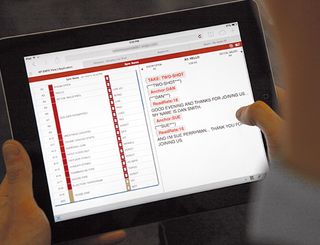In Newsroom Systems, It’s One for All

Consolidation may be one of the bigger buzzwords in the station business, but it’s just as big a term with it comes to tech operations,and that goes double for software. Vendors are busy enlarging the capabilities of newsroom software systems, developing ways for them to run more aspects of station operations and broadcast news production. Meanwhile, newer IT and IP technologies are transforming the way stations work.
The changes are no surprise. Newsrooms were one of the earliest adopters when it came to tapping in to the useful power of software systems in terms of news operations. Now, many stations are moving to technical infrastructures more heavily based on software.
Vendors including Avid, Dalet, Grass Valley, Harmonic and Sony are pitching over-arching software systems meant to manage broadcast operations, which could rework the role of newsroom systems. Avid is pitching its “Avid Everywhere” vision of providing clients with tools to produce, monetize and distribute content in a single, highly efficient system.
“Our focus has been to reimagine the newsroom system as part of a larger integrated workflow that really ties everyone together and enables collaborative [work],” says Pam Gill, senior segment marketing manager for broadcast and media at Avid.
This has prompted all the major providers of newsroom systems to develop tools to streamline the delivery of content to TV and an ever-growing number of digital platforms. “Our customers want one production system for all those platforms,” says Wayne Ludkey, director of sales for the Americas at the Associated Press’ ENPS newsroom system, which is used by about 60% of the U.S. market’s stations, and has around 70,000 users worldwide.
As broadcasters deliver more content to online and mobile devices, they are also relying more heavily on mobile devices in their news operations. AP and Avid have had mobile apps available for some time and are now expanding both the features and the devices they reach. Both companies have plans to launch Android versions of their existing iOS mobile apps sometime in June.
“We’ve had a mobile client for about four years and we’ve always felt that everyone should be working on the same systems,” says Ludkey. “But the technology is finally catching up so that we can offer a unified news production system whether people are in the newsroom or in the field…the efficiency of the crews in the field has gone up immensely.”
Broadcasting & Cable Newsletter
The smarter way to stay on top of broadcasting and cable industry. Sign up below
Another major area of development comes with social media tools, given its growing importance both for newsgathering and as a way to engage and inform viewers. Toward that end, last September, Ross Video launched Inception, its first newsroom system, which grew out of Inception Social to easily integrate social media into news production workflows. It has since been expanded into a system with fuller capability. “It is a modern platform designed from the start for today’s technologies,” says Jeff Moore, executive VP and CMO at Ross Video. “It uses Web technologies, so all you need is a browser to log in anywhere in the world and the notion of multiplatform publication is built right into the product.”
Software is King
The transformation of newsroom systems comes at a time when a number of major vendors such as Avid, Grass Valley and Dalet have launched larger, overarching software systems that are designed to run most of a station or network’s operation.
The NBC owned stations, for example, are in the process of rolling out Grass Valley’s Stratus, which the vendor calls a “media workflow application framework.” In the recently launched new L.A. facility for KNBC, the Stratus software is used to manage the creation and movement of content through their systems, providing a unified media asset management system, a single platform for editing on Grass Valley Edius and a central repository for content that interfaces with Avid’s iNews.
That dynamic is also pushing providers of some of these larger production systems into creating newsroom systems. Dalet will be launching a newsroom system at this year’s IBC that is designed to improve efficiency and multiplatform delivery, says Raoul Cospen, director of marketing and business development at the company.
But Ludkey and others don’t think the move to more powerful software systems will diminish the importance of newsroom systems. “AP ENPS is really more of a [total asset manager],” he argues. “We still are the system that conducts the orchestra.”
Delivery Push All About Efficiency
Much of the push to improve tools for social media and multiplatform delivery and to expand access to newsroom systems from the field so crews can create more content comes down to the ongoing drive to make newsroom operations more efficient.
“The demand for news content is growing…but often news broadcasters don’t have the budget to bring on multiple people as they are still trying to figure out how to monetize news content on the Web, mobile and social media,” says Pam Gill, senior segment marketing manager for broadcast and media at Avid. “So automating non-creative tasks and making the best use of their resources is a major focus.”
A key part of that involves better media asset management (MAM) systems, says Raoul Cospen, director of marketing and business development at Dalet. “Our approach is to begin with the MAM,” he says. “It is the key to optimizing workflows, efficiency, multiplatform delivery and the ability to speed up the process of putting news on the air.”
By focusing on media management and metadata, this also makes it easier to make money from archives and news content. “If you are going to be able to use content you have to be able to track it through the broadcast infrastructure,” he says.
